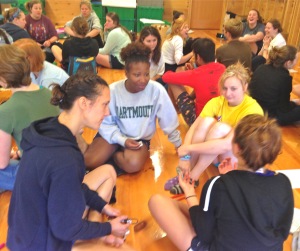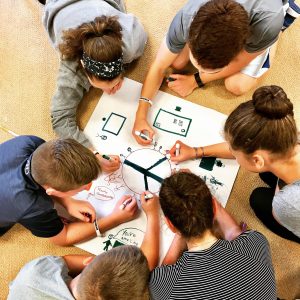Jan 31, 2018 Facilitating Reflection: Challenges and Opportunities
Helping facilitators and educators view reflection differently and find ways to make it meaningful and engaging has been a focus of my professional work over the past two decades. Although educators and facilitators agree that reflection is a fundamental aspect of learning, teaching, and group work, some find it quite challenging. It can feel like a chore, a rote follow up. The same group members always speak. The answers and discussion seem more about what the group thinks the facilitator wants to hear rather than meaningful reflection and connection making. It often gets left to the last minute and missed because of lack of time.

Traditionally, facilitators use verbal methods to facilitate reflection on experiences, reinforce lessons, and/or help the group define meaning in an experience. Many of us were trained to lead a facilitator-directed, question-and-answer session following an experience. We were encouraged to ask open-ended questions, using Terry Borton’s (1970) helpful model of structuring questions to cover “what happened,” “so what,” and “now what.”
Despite our best efforts, and even with years of experience, many of our reflective sessions still fell flat. Although there is value in verbal group discussion and insights offered by the facilitator, this approach has its limitations. Many participants and facilitators are intimidated by this kind of whole-group, verbal Q & A discussion, especially at the beginning of group experience before participants have built rapport and trust within their group. Also, this approach is very facilitator/or leader directed. The facilitator chooses questions to target their goals and perceptions of the lessons learned, but in doing so, they might miss important teachable moments the group encountered along the way.
I have experimented with many innovative ways to engage groups in dialogue and reflection—kinesthetically, emotionally, metaphorically and socially—that aren’t dependent on the facilitator leading a didactic question-and-answer session. It has become my professional mission in the field to develop and share a wide range of participant centered techniques that add depth, increase engagement, and promote ownership and buy-in on the part of learners. Along with using varied tools and techniques, it is a facilitator’s attitude toward reflection and flexibility around when and how it happens that makes all of the difference. If a facilitator sees it as an engaging, dynamic, and enjoyable part of group work, rather than a chore, it is likely their group will experience it that way too.

Facilitating and timing reflection depend on each group’s needs and goals. Opportunities for creating meaning and connection can be woven into an activity or initiative itself. Good facilitators learn to read their groups, use a variety of techniques, and look for opportunities to reinforce key learning or teachable moments as they happen.
To facilitate engaging and effective reflection, use activities that give participants the power to take the lead. It is helpful to let go of the idea of reflection being a report out to the group. Meaningful reflection doesn’t necessarily need to be heard by the facilitator or whole group to be effective.
In my last post I shared about a study by UNC, Harvard Business School and HEC Paris that showed the positive impact of reflection on performance with researchers finding the act of sharing reflection with the group or facilitator had little or no impact on performance outcomes. I find this compelling, as many of us operate under the assumption that the group has to hear it for it to be a meaningful reflective experience. I do think there are benefits to sharing with the whole group such as learning how to express ideas and speak in front of a group, peer teaching, and building empathy and understanding within the group. It can also be useful for data gathering on the part of the instructor or facilitator. However, the large group share doesn’t have to happen all of the time.
Excerpt from Tips and Tools for the Art of Experiential Group Facilitation by Jennifer Stanchfield
References:
Borton,T. (1970). Reach, touch, and teach: Student concerns and process education. New York: McGraw-Hill
Di Stefano, G., Gino, F., Pisano, G. P., & Staats, B. R. (2014, March 25). Learning by thinking: How reflection aids performance. Harvard Business School Technology & Operations Mgt. Working Paper No. 14-093.



No Comments